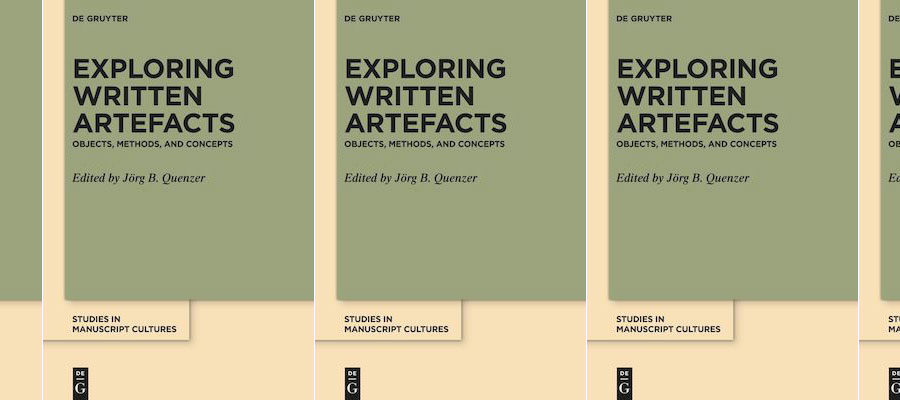Jörg B. Quenzer, ed. Exploring Written Artefacts: Objects, Methods, and Concepts. 2 volumes. Studies in Manuscript Cultures, volume 25. De Gruyter, 2021. [Open Access. DOI: https://doi.org/10.1515/9783110753301]
From De Gruyter
This collection, presented to Michael Friedrich in honour of his academic career at of the Centre for the Study of Manuscript Cultures, traces key concepts that scholars associated with the Centre have developed and refined for the systematic study of manuscript cultures. At the same time, the contributions showcase the possibilities of expanding the traditional subject of ‘manuscripts’ to the larger perspective of ‘written artefacts’.
CONTENTS INCLUDE
‘Paleografia quale scienza dello spirito’: Once More on the Gǝʿǝz Inscription of Ham (RIÉ no. 232)
Alessandro Bausi
First published by Giorgio Brunetti in 1927 and re-edited by Carlo Conti Rossini in 1939, the inscription of Ham (RIÉ no. 232) has since received attention from several scholars in Ethiopian and Eritrean studies, from Ugo Monneret de Villard to Enrico Cerulli, Sergew Hable Selassie, and, in the last twenty-five years, Gianfranco Fiaccadori and Manfred Kropp. The latter author has proposed a precise dating to 873 CE, before the recent appearance of the posthumous contribution by Abraham Johannes Drewes, who is the last one to have systematically discussed the inscription. Without pretending to solve all problems that arise from the inscription, the scope of the present note is to pro-vide a fresh re-examination of some of the palaeographic and linguistic features of the Ham inscription, which remains a Gǝʿǝz epigraphic document of exceptional importance for the Ethiopian and Eritrean Middle Ages, and to propose a dating to 23 December 974 CE.
Creating an Original of a Greek Lexicon in the Middle Ages: Notes on the Manuscript Vaticanus Barberinianus gr. 70 of the Etymologicum Gudianum
Stefano Valente
The creation of a lexicon in the manuscript culture of the Greek Middle Ages was a complex and difficult enterprise. It required access to different manu-script sources and to writing materials in which the selected information could be copied and structured. To illustrate this practice, some features of the manuscript Vatican City, BAV, Vaticanus Barberinianus gr. 70 (eleventh century CE?) transmit-ting the original of the so-called Etymologicum Gudianum will be investigated.
A Multilayered Greek Manuscript of Learning: Some Glimpses into the Scribal Practices Evident in the Aristotelean Codex Vaticanus graecus 244
Christian Brockmann
In the Greek study manuscripts of the Aristotelean tradition, the goal of combining and relating extensive core content and extensive para-content in such a way that constant interaction becomes possible, has been achieved in an exemplary manner. After introductory remarks on the complex and often multi-layered formatting of this type of manuscripts, a closer look is taken at the Organon codex Vat. gr. 244. The way in which Aristotle’s Analytica Posterioraare explained in this manuscript in large marginal commentaries is illustrated by the analysis of a sample passage.
Hidden Colophons
Jost Gippert
On the basis of Georgian codices from the collection of the Iviron Monastery on Mt Athos, the article examines a special purpose of using red ink in medieval manuscripts, namely, to provide information concerning the manuscript in question and the people involved in its production (scribes, authors, translators, or commissioners) by scattering sequences of individual letters over one or two pages. After discussing authentic accounts of the use of rubrics in the Georgian manuscript production of the eleventh century, the shape and scope of ‘hidden colophons’ is illustrated by reference to four codices of the monastery (Ivir. georg. 4, 9, 16, and 61).
A Lesser-Known Member of Bessarion’s Milieu: The Scribe-Bishop Makarios
Luigi Orlandi
This paper aims to examine some Greek manuscripts produced in the mid-fifteenth century. Prosopographic, palaeographic and codicological pieces of evidence lead to the identification of the handwriting of the scribe-bishop Makarios.
The Letters of Michael Psellos and their Function in Byzantine Epistolary Culture
Michael Grünbart
The transmission of Byzantine letters still lacks a new interpretative approach, leaving aside the idea of an archetypus. Michael Psellos’ letters (eleventh century) may serve as an example to demonstrate how the process of rhetorical recycling and re-using of letters worked. His letters are preserved in a large number of manuscripts, but none of them contains a complete collection. Similarly to the late-antique epistolographer Libanios, Psellos became a model of letter writing for later generations and parts of his texts have been adapted in new contexts. The Psellian letter collection therefore offers an excellent case-study to analyse how his manuscripts and texts were used again and again in the course of history.
